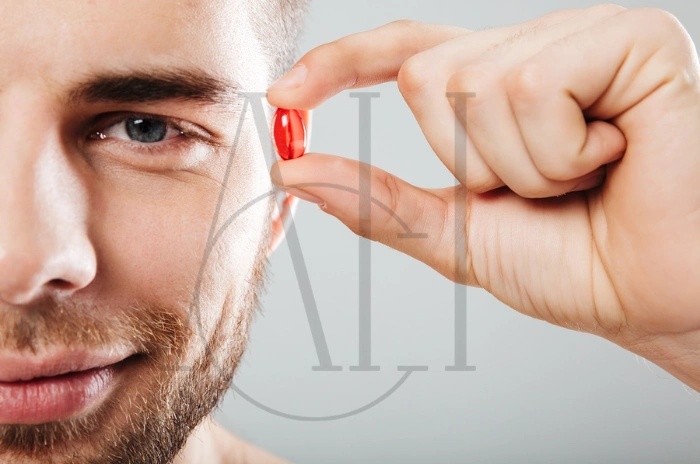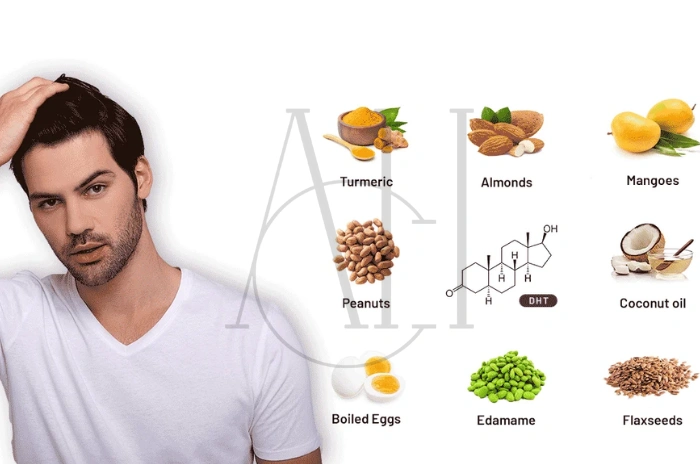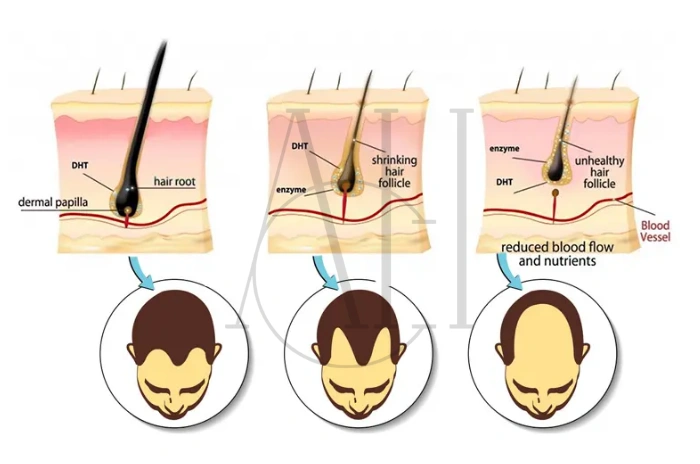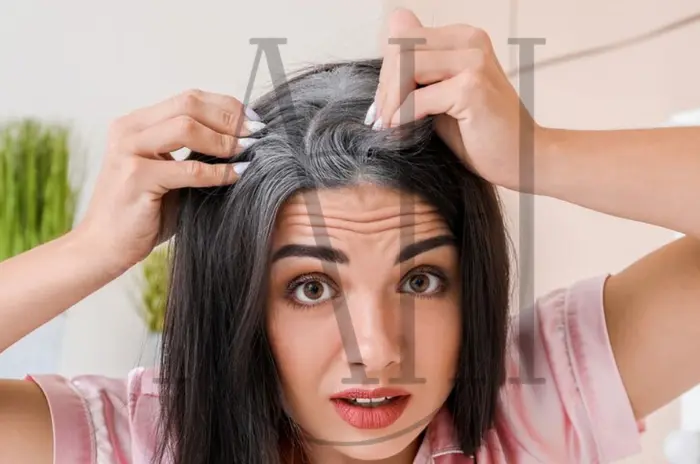DHT hormone plays a crucial role in human development and adult physiology, but it’s also the primary culprit behind male pattern baldness and various other health conditions. Understanding dihydrotestosterone and its effects on hair loss, prostate health, and overall well-being is essential for anyone experiencing hair thinning or seeking to optimize their hormonal balance. This comprehensive guide explores everything you need to know about DHT and hair loss, from its production mechanisms to effective management strategies.
Table of Contents
ToggleWhat Is DHT and How Is It Produced?
Dihydrotestosterone is a potent androgen hormone derived from testosterone through enzymatic conversion. This DHT hormone is approximately five times more powerful than testosterone in its androgenic effects, making it a critical player in male sexual development and various physiological processes throughout life.
The conversion process involves the enzyme 5-alpha reductase, which transforms testosterone into DHT in specific tissues. This biochemical transformation occurs primarily in androgen-sensitive organs, including hair follicles, prostate gland, and sebaceous glands. Understanding DHT production is fundamental to comprehending its role in conditions like androgenic alopecia and prostate enlargement.
The Role of Testosterone in DHT Formation
Testosterone and DHT are closely related hormones within the androgen family. While testosterone serves as the precursor, DHT represents the more potent, tissue-specific form that exerts stronger androgenic effects. The conversion occurs when testosterone encounters 5-alpha reductase enzymes in target tissues.
This enzymatic process is irreversible under normal physiological conditions. Once testosterone transforms into DHT, it binds more readily to androgen receptors and remains active for longer periods. This enhanced potency explains why DHT has such pronounced effects on hair follicles and prostate tissue, even when present in relatively small concentrations compared to testosterone.
Where DHT Is Produced in the Body
DHT metabolism occurs in various tissues throughout the body, with the highest concentrations found in the prostate, hair follicles, and sebaceous glands. The skin contains significant amounts of 5-alpha reductase, particularly in areas prone to male pattern baldness such as the scalp vertex and frontal regions.
DHT in prostate tissue is produced locally, contributing to both normal prostate function and pathological conditions like benign prostatic hyperplasia. Other production sites include the liver, muscles, and adipose tissue, though these contribute less to circulating DHT levels. The localized production explains why DHT blockers can be effective in treating specific conditions without dramatically affecting overall hormone levels.
DHT’s Role in Hair Loss
DHT and hair loss represent one of the most well-documented hormone-related conditions affecting millions worldwide. The relationship between dihydrotestosterone and hair follicle miniaturization has been extensively studied, revealing the precise mechanisms by which this DHT hormone contributes to androgenic alopecia.
Hair follicles in genetically susceptible individuals contain androgen receptors that are particularly sensitive to DHT. When DHT binds to these receptors, it initiates a cascade of cellular changes that gradually shrink the hair follicle, leading to progressively thinner and shorter hair strands until the follicle eventually stops producing visible hair altogether.
How DHT Affects Hair Follicles
The process of DHT-induced hair loss begins at the cellular level within hair follicles. High DHT levels cause follicles to enter a prolonged resting phase, reducing the time spent in the active growth phase. This shift in the hair growth cycle results in increasingly miniaturized hair strands that become virtually invisible over time.
DHT also reduces blood flow to affected follicles, limiting the delivery of essential nutrients required for healthy hair growth. The hormone triggers inflammation around the follicle, creating an environment hostile to normal hair production. These combined effects explain why DHT treatment focuses on both blocking the hormone’s action and supporting follicle health through improved circulation and nutrition.
Male Pattern Baldness and DHT
Male pattern baldness represents the most common form of hair loss, affecting approximately 50% of men over age 50. DHT and male pattern baldness are inextricably linked, with genetic sensitivity to dihydrotestosterone determining both the onset and progression pattern of hair loss.
The characteristic “M-shaped” hairline recession and crown thinning associated with male pattern baldness directly correlate with areas of highest DHT concentration and follicle sensitivity. Men with high DHT symptoms often notice accelerated hair loss in these regions, while areas like the sides and back of the head typically remain unaffected due to lower DHT sensitivity.
Can DHT Cause Hair Loss in Women?
DHT in women can indeed cause hair loss, though the pattern typically differs from male baldness. Female pattern hair loss usually presents as diffuse thinning across the crown rather than distinct bald patches. Symptoms of high DHT in women may include increased facial hair growth, irregular menstrual cycles, and gradual hair thinning.
Women experiencing DHT-related hair loss often have underlying hormonal imbalances, such as polycystic ovary syndrome (PCOS) or menopause-related hormonal changes. DHT blockers can be effective for women, though treatment approaches may differ from those used in men due to different hormonal profiles and potential side effects.
Symptoms and Effects of High DHT Levels
High DHT symptoms extend beyond hair loss, affecting various aspects of physical appearance and health. Recognizing these signs early can help individuals seek appropriate DHT testing and treatment before symptoms become severe or irreversible.
The most obvious symptoms of high DHT include accelerated hair loss, particularly in the crown and temporal regions. However, elevated DHT levels can also manifest through increased body hair growth, acne breakouts, and changes in voice or body composition. Understanding these symptoms helps differentiate DHT-related issues from other hormonal imbalances.
Physical Signs in Men and Women
In men, high DHT symptoms typically include rapid hair loss progression, increased facial and body hair growth, and potential prostate enlargement symptoms such as frequent urination or difficulty starting urination. Some men may also experience increased aggression or mood changes associated with elevated androgen levels.
Women with elevated DHT may notice male-pattern hair loss, hirsutism (excessive body hair growth), deepening voice, and irregular menstrual periods. DHT side effects in women can also include acne, particularly along the jawline and chin, and changes in body fat distribution. These symptoms often indicate the need for comprehensive DHT testing and hormonal evaluation.
Other Health Effects of Elevated DHT
Beyond hair and skin changes, high DHT levels can impact cardiovascular health, mood regulation, and sleep patterns. Some studies suggest correlations between elevated DHT and increased risk of cardiovascular disease, though the exact mechanisms remain under investigation.
DHT and prostate health are closely connected, with elevated levels potentially contributing to benign prostatic hyperplasia and related urinary symptoms. The hormone may also influence insulin sensitivity and metabolic function, though these effects vary significantly among individuals and depend on overall hormonal balance and genetic factors.

How to Test and Control DHT Levels
DHT testing provides valuable insights into hormonal status and helps guide appropriate treatment decisions. Understanding when and how to test DHT levels, along with available control methods, empowers individuals to take proactive steps in managing their hormonal health.
Modern DHT testing methods include blood tests, saliva tests, and specialized hormone panels that measure both DHT and related hormones like testosterone and 5-alpha reductase activity. These tests help healthcare providers determine whether elevated DHT levels contribute to specific symptoms and guide personalized treatment approaches.
| DHT Testing Method | Accuracy | Cost | Sample Type | Results Time |
|---|---|---|---|---|
| Blood Serum Test | High | $$ | Blood draw | 2-3 days |
| Saliva Test | Moderate | $ | Saliva sample | 3-5 days |
| Comprehensive Hormone Panel | Very High | $$ | Blood + Urine | 5-7 days |
| Home Test Kits | Moderate | $ | Saliva/Blood spot | 7-10 days |
When Should You Get Tested for DHT?
DHT testing is recommended for individuals experiencing rapid hair loss, particularly when it follows the characteristic patterns of androgenic alopecia. Men with early-onset male pattern baldness or women with signs of hyperandrogenism should consider comprehensive hormonal evaluation including DHT measurement.
Other indications for DHT testing include prostate symptoms in men, irregular menstrual cycles in women, persistent acne in adults, and unexplained changes in body hair distribution. Family history of pattern baldness or prostate issues may also warrant earlier testing to establish baseline levels and implement preventive strategies.
Treatment Options to Reduce DHT
DHT blockers represent the primary medical approach to managing elevated dihydrotestosterone levels. Finasteride and dutasteride are FDA-approved DHT blockers that inhibit 5-alpha reductase enzyme activity, effectively reducing DHT production by 60-90% in treated individuals.
| DHT Blocker | DHT Reduction | Primary Use | Common Dosage | Effectiveness Timeline |
|---|---|---|---|---|
| Finasteride | 60-70% | Hair loss, BPH | 1mg (hair), 5mg (prostate) | 3-6 months |
| Dutasteride | 85-90% | BPH, Hair loss | 0.5mg daily | 4-6 months |
| Saw Palmetto | 20-30% | Natural supplement | 160-320mg daily | 6-12 months |
| Topical Solutions | 30-50% (local) | Hair loss | Varies by product | 2-4 months |
How to reduce DHT naturally includes dietary modifications, specific supplements, and lifestyle changes. Saw palmetto, pumpkin seed oil, and green tea extract have shown potential DHT-blocking properties in various studies. Regular exercise, stress management, and adequate sleep also support healthy hormone balance and may help optimize DHT levels naturally.
Side Effects of High or Low DHT Levels
Both elevated and deficient DHT levels can cause significant health issues, making balanced hormone levels crucial for optimal well-being. Understanding the DHT side effects associated with both extremes helps individuals and healthcare providers make informed treatment decisions.
High DHT creates obvious problems like accelerated hair loss and prostate issues, while low DHT levels can lead to decreased libido, reduced muscle mass, and potential mood changes. Finding the optimal balance requires careful monitoring and individualized treatment approaches.
Common Symptoms of High DHT
High DHT symptoms most commonly include aggressive pattern hair loss, particularly rapid progression in genetically susceptible individuals. Men may experience prostate enlargement symptoms, increased body hair growth, and potential mood changes including increased aggression or irritability.
| High DHT Symptoms | Men | Women | Severity Level |
|---|---|---|---|
| Pattern Hair Loss | Crown & temples | Diffuse thinning | High |
| Increased Body Hair | Chest, back, face | Face, chest, arms | Moderate |
| Acne | Face, back, chest | Jawline, chin | Moderate |
| Prostate Issues | Frequent urination, weak stream | N/A | High |
| Voice Changes | Minimal | Deepening | High |
| Mood Changes | Increased aggression | Irritability | Low-Moderate |
Additional symptoms of high DHT can include persistent acne, particularly in adults who previously had clear skin, oily skin and scalp, and in women, signs of virilization such as deepening voice or increased muscle mass. These symptoms often develop gradually, making early recognition and intervention crucial for effective management.
Health Risks of Low DHT
Low DHT symptoms can include decreased libido, reduced muscle mass and strength, fatigue, and potential mood changes including depression or anxiety. Some men with very low DHT levels may experience difficulty maintaining normal sexual function or reduced motivation and energy levels.
Low DHT can also affect bone density over time, particularly in older adults. However, it’s important to note that moderately reduced DHT levels, such as those achieved through DHT blockers for hair loss treatment, rarely cause severe side effects and are generally well-tolerated by most individuals.
DHT’s Role in Hair Loss and Prostate Health
The relationship between DHT, hair loss, and prostate health represents two of the most significant clinical concerns related to dihydrotestosterone. Understanding how DHT affects these systems helps explain why DHT blockers are used to treat both conditions and why monitoring is essential during treatment.
DHT in prostate tissue serves important functions during development but can contribute to problematic enlargement in older men. Similarly, DHT and hair loss mechanisms involve the same hormone-receptor interactions that occur in prostate tissue, explaining why treatments often address both conditions simultaneously.
How DHT Causes Male and Female Hair Loss
DHT and male pattern baldness involve a complex interplay between genetic susceptibility, hormone levels, and follicle sensitivity. The DHT hormone binds to androgen receptors in hair follicles, triggering a miniaturization process that gradually reduces hair diameter and length until follicles become dormant.
In women, DHT can cause diffuse hair thinning across the crown and top of the scalp. Female pattern hair loss typically occurs later in life, often coinciding with menopause when protective estrogen levels decline. How to reduce DHT becomes particularly important for women experiencing this type of hair loss, as it can significantly impact self-esteem and quality of life.
DHT’s Impact on the Prostate Gland
DHT and prostate health are intimately connected, with the hormone playing essential roles in prostate development and function. However, elevated DHT in prostate tissue can contribute to benign prostatic hyperplasia (BPH), causing urinary symptoms and potential complications in older men.
The same DHT blockers used for hair loss treatment often improve prostate symptoms, demonstrating the hormone’s central role in both conditions. 5-alpha reductase inhibitors effectively reduce prostate size and improve urinary flow while simultaneously slowing hair loss progression, making them valuable dual-purpose treatments.

How to Manage DHT Levels
Effective DHT management requires a comprehensive approach combining medical interventions, lifestyle modifications, and ongoing monitoring. How to reduce DHT depends on individual circumstances, symptom severity, and treatment goals, with options ranging from natural approaches to prescription medications.
Successful DHT treatment often involves addressing underlying factors that contribute to elevated levels, such as insulin resistance, chronic stress, or nutritional deficiencies. A holistic approach typically yields better long-term results than relying solely on pharmaceutical interventions.
Medical Treatments for High DHT (DHT Blockers)
DHT blockers like finasteride and dutasteride represent the most effective medical treatments for reducing dihydrotestosterone levels. These medications inhibit 5-alpha reductase enzymes responsible for converting testosterone to DHT, achieving significant reductions in hormone levels within weeks of starting treatment.
Topical DHT blockers offer alternative options for individuals who cannot tolerate oral medications or prefer localized treatment. These formulations can target specific areas like the scalp without significantly affecting systemic DHT levels, potentially reducing the risk of side effects while maintaining therapeutic benefits.
Natural Ways to Balance DHT
How to reduce DHT naturally involves dietary modifications, supplementation, and lifestyle changes that support healthy hormone balance. Foods rich in zinc, such as pumpkin seeds and oysters, may help regulate 5-alpha reductase activity and reduce DHT production.
| Natural DHT Management | Method | Effectiveness | Time to Results | Side Effects |
|---|---|---|---|---|
| Saw Palmetto Extract | Supplement | Moderate | 3-6 months | Minimal |
| Pumpkin Seed Oil | Dietary/Supplement | Low-Moderate | 4-8 months | None |
| Green Tea Extract | Supplement/Drink | Low | 6-12 months | Minimal |
| Zinc Supplementation | Supplement | Low-Moderate | 2-4 months | Stomach upset |
| Regular Exercise | Lifestyle | Moderate | 2-3 months | None |
| Stress Management | Lifestyle | Moderate | 1-2 months | None |
Natural DHT management also includes stress reduction techniques, regular exercise, and adequate sleep, all of which influence hormone production and metabolism. Herbal supplements like saw palmetto, nettle root, and green tea extract have shown potential DHT-blocking properties in various studies, though their effects are generally milder than prescription medications.
Where and How DHT Is Produced
Understanding DHT production mechanisms provides insights into why certain treatments work and how lifestyle factors influence hormone levels. Dihydrotestosterone synthesis occurs through well-characterized biochemical pathways involving specific enzymes and tissue types.
The complexity of DHT metabolism explains why some individuals are more susceptible to DHT-related conditions than others and why treatment responses vary significantly among patients. DHT biochemistry involves multiple steps and regulatory mechanisms that can be influenced by genetics, age, and environmental factors.
Role of 5‑Alpha‑Reductase Isoenzymes
5-alpha reductase exists in two main forms (Type I and Type II) with different tissue distributions and characteristics. Type II 5-alpha reductase predominates in hair follicles and prostate tissue, making it the primary target for DHT blockers used in treating hair loss and prostate conditions.
| 5-Alpha Reductase Type | Primary Location | DHT Production | Targeted by | Clinical Significance |
|---|---|---|---|---|
| Type I | Sebaceous glands, skin | 30% of total DHT | Dutasteride only | Acne, oily skin |
| Type II | Hair follicles, prostate | 70% of total DHT | Finasteride & Dutasteride | Hair loss, BPH |
| Combined Activity | Throughout body | 100% of DHT | Dual inhibitors | Comprehensive treatment |
Type I 5-alpha reductase is more prevalent in sebaceous glands and skin, contributing to conditions like acne and oily skin. Understanding these different enzyme types helps explain why some DHT treatments are more effective for certain conditions and why combination approaches may be necessary for comprehensive hormone management.
Classical vs. Backdoor Pathways
DHT production can occur through multiple biochemical pathways, with the classical route involving direct conversion of testosterone by 5-alpha reductase. However, alternative “backdoor” pathways can produce DHT through different intermediates, potentially bypassing traditional DHT blockers.
These alternative pathways may explain why some individuals don’t respond optimally to standard DHT treatments and why comprehensive hormonal assessment is important. Understanding DHT metabolism complexity helps healthcare providers develop more effective, personalized treatment strategies for managing dihydrotestosterone-related conditions.
DHT’s Biological Roles Throughout Life
DHT hormone function extends far beyond its role in hair loss and prostate health, playing crucial roles in sexual development, growth, and various physiological processes throughout the human lifespan. Understanding these broader functions helps explain why DHT balance is important for overall health and why treatment decisions require careful consideration.
The hormone’s effects vary significantly depending on life stage, with critical roles during prenatal development, puberty, and adult life. DHT vs. testosterone comparisons reveal unique functions that cannot be replaced by other androgens, highlighting the hormone’s specialized importance in human physiology.
DHT in Prenatal Sexual Development
During fetal development, DHT plays essential roles in male sexual differentiation, particularly in external genital development. The hormone is crucial for proper formation of the penis, scrotum, and prostate gland, with deficiencies potentially leading to various developmental disorders.
DHT hormone function during this critical period cannot be replaced by other androgens, making adequate hormone production essential for normal male development. Understanding these fundamental roles helps explain why DHT remains important throughout life, even when managing conditions like hair loss requires hormone reduction.
DHT’s Effects During Childhood & Puberty
Throughout childhood, DHT levels remain relatively low, with significant increases occurring during puberty when the hormone contributes to various masculinizing changes. Dihydrotestosterone influences voice deepening, muscle development, and the growth of facial and body hair that characterizes male puberty.
During this developmental period, DHT also begins affecting hair follicles in areas that will later become susceptible to pattern baldness. Genetic variations in DHT sensitivity often become apparent during or shortly after puberty, when individuals may first notice differences in hair thickness or growth patterns.
DHT in Adult Prostate and Hair Growth
In adult men, DHT continues to influence prostate function and hair growth patterns. DHT and prostate health remain interconnected throughout adult life, with the hormone supporting normal prostate function while potentially contributing to age-related enlargement.
Adult hair follicles maintain their DHT sensitivity, with continued exposure gradually affecting follicle function in genetically susceptible individuals. This ongoing process explains why male pattern baldness typically progresses slowly over decades and why early intervention with DHT blockers can be more effective than waiting until significant hair loss has occurred.
How DHT Affects the Body
DHT hormone influences multiple body systems beyond its well-known effects on hair and prostate tissue. Understanding these broader impacts helps individuals make informed decisions about DHT treatment while considering potential benefits and risks across different organ systems.
The hormone’s effects on skin, muscle, bone, and metabolic function demonstrate its importance in maintaining various aspects of male physiology. However, these same effects can contribute to problems when DHT levels become elevated or when genetic sensitivity creates adverse responses.
DHT’s Role in Hair Loss (Androgenic Alopecia)
Androgenic alopecia represents the most common form of hair loss, affecting both men and women through DHT-mediated follicle miniaturization. The process involves complex interactions between dihydrotestosterone, androgen receptors, and genetic factors that determine individual susceptibility and progression patterns.
DHT and hair loss mechanisms include inflammation, reduced blood flow, and altered growth factor production within affected follicles. These changes create a hostile environment for hair growth, eventually leading to follicle dormancy and permanent hair loss if left untreated. Early intervention with DHT blockers can often halt or slow this progression significantly.
DHT and Acne: What’s the Connection?
DHT stimulates sebaceous gland activity, leading to increased oil production that can contribute to acne development. High DHT levels often correlate with persistent adult acne, particularly in areas with high concentrations of sebaceous glands such as the face, chest, and back.
The hormone’s effects on skin also include increased cell turnover and potential inflammation, creating conditions favorable for acne formation. DHT treatment approaches that reduce hormone levels often improve acne symptoms, though topical treatments may be preferred for individuals primarily concerned with skin issues rather than hair loss.
DHT’s Impact on Prostate Health
DHT in prostate tissue serves important functions but can contribute to benign prostatic hyperplasia (BPH) as men age. The hormone stimulates prostate cell growth and can lead to urinary symptoms when the enlarged gland compresses the urethra.
DHT and prostate health concerns often develop gradually, with symptoms including frequent urination, difficulty starting urination, and weak urine stream. DHT blockers used for prostate treatment can significantly improve these symptoms while also providing hair loss benefits, making them attractive options for men experiencing both conditions.
FAQ : DHT (Dihydrotestosterone) Hair Loss Causes Effects and How to Manage It
What exactly is DHT, and how is it produced in the body?
DHT (dihydrotestosterone) is a potent androgen hormone produced when testosterone is converted by the enzyme 5-alpha reductase, primarily in hair follicles, prostate tissue, and sebaceous glands.
What role does DHT play in hair loss, particularly in male and female pattern baldness?
DHT binds to androgen receptors in genetically susceptible hair follicles, causing them to miniaturize over time, leading to progressively thinner hair and eventual baldness in characteristic patterns.
What are the common symptoms and health effects of having high DHT levels?
High DHT symptoms include accelerated hair loss, increased body hair growth, acne, prostate enlargement in men, and in women, hirsutism, irregular periods, and voice deepening.
What are the potential health risks or side effects associated with low DHT levels?
Low DHT levels can cause decreased libido, reduced muscle mass, fatigue, mood changes, and potentially affect bone density, though moderate reductions from DHT blockers are generally well-tolerated.
How are DHT levels typically tested, and when should someone consider getting tested?
DHT testing involves blood or saliva tests and should be considered when experiencing rapid hair loss, prostate symptoms, irregular hormonal symptoms, or family history of related conditions.
What are the main treatment options available to control or reduce high DHT levels?
DHT treatment options include prescription DHT blockers like finasteride and dutasteride, topical treatments, and natural approaches including dietary modifications, supplements, and lifestyle changes.
Beyond hair loss, what other significant biological roles does DHT play in the body throughout life?
DHT is essential for prenatal male sexual development, puberty changes, prostate function, muscle development, and various metabolic processes throughout the male lifespan.
Can managing DHT levels help with conditions like acne or prostate issues, in addition to hair loss?
Yes, DHT management can improve acne by reducing sebaceous gland activity and help with prostate symptoms by reducing gland size, making DHT blockers effective for multiple conditions simultaneously.





